DownEast_Detecting
Sr. Member
I went for my second beach hunt ever today. im way more into the history/relics, but this tiny beach is right down the road from Colonial Pemaquid. (see red circle on old map below) This whole area is one of the oldest in Maine. In In 1605, George Waymouth and Englishman, with 29 men landed at Pemaquid. This is 2 years before the settlement of the first permanent colony at Jamestown, Virginia. And fifteen years before the landing of the Pilgrims at Plymouth. He had intended to go ashore in Cape Cod. But fearful that the sand and shoals would provide too poor an anchorage, he continued north and east. After spending some time among the islands in the surround waters. He explored the mainland for a week. While there he captured 5 native Americans and took them back to England. They apparently lived with the better English families and were well treated. Since several of them upon their return to America acted as guides for Captain John Smith and other early explorers for the many islands, rivers, bays, and inlets of the Maine coast.
In the early days Pemaquid represented an important strategic position. It was the last outpost between the Englsih and the French. Both of whom claimed territory between the Kennebec and St. Croix river. The history of Pemaquid is closely tied with the rise and fall of the four forts that have been built there. Briefly the first fort, Fort Pemaquid was erected in 1630.And was burned by the Native Americans in 1676. The fort was replaced by Fort Charles in 1677. Which in turn was destroyed during the Native American massacre of 1689. Then in 1692 Fort William Henery, the first stone fort in New England was built. This lasted only four years. In 1696 it was captured by the French fleet under D'Iberville. Supported on land by a band of several hundred Native Americans under Castine. For the next 30 years the entire peninsula was deserted due to fear of the Native Americans. Then David Dunbar was commissioned to build the fourth and last fort, Fort Frederick in 1729. This fort lasted for 46 years, until it was torn down by the citizens of the town of Bristol in 1775. To keep it out of the hands of the British during the Revolutionary War.


These are the finds form the permission.
#1 biggest spoon bowl ive dug, but probably 1800's. not great a dating spoons yet.
#2 round ball or fishing weight?
#3 jackknife not sure how old but probably not more that 50-75 years.
#4 Chape, im hoping is colonial right?
#5 show buckle frame i believe.
#6 rose head nail? so old right? hand wrought?






Now these are my finds from the little beach, which i assume has been hunted thoroughly. But pulled quite of lot of stuff.


#7 and #8 modern-ish silverware. #8 is a "big ol" spoon
#9 a buddha
#10 a pocket watch. I dont think this one is as old as the one i pulled from big beach around the corner.
#11 button
#12 i have no idea. lead that someone was cutting pieces from?
#13 old toy car
#14 no idea. anybody?
#15 what do they call that. a pour off or something?
#16 I really have no idea. This thing is weird, found together. Probably post this in what is it. If nobody knows here.
#17 is this scrap lead with a hole in it?
#18 one looks like a cuff link, not sure about the other.
#19 encrusted coin. not much left of it. i broke into it.
#20 The smallest target i have ever dug. some brass washer i think
#21 buckles of some sort. are they old? are they horsey stuff? not sure
#22 old school washers?
the rest is various bits and bobs. i dont think any of it is old.















here is a birds eye view of one of the archeological excavations of the village around the fort in the 1960's. (Talk about some cellar holes i would like to detect around.) and just a tiny sampling of stuff they found then.They found 8,000 pipe pieces. The Maine State if kinda slacking if you ask me. I feel like a proper more extensive dig should be done here.





and some thumbnails for full images if you are on a phone.
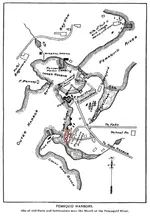
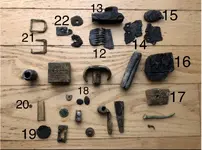
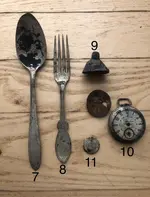
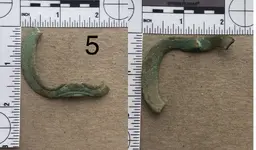
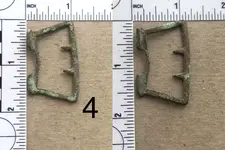
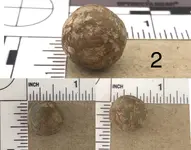
In the early days Pemaquid represented an important strategic position. It was the last outpost between the Englsih and the French. Both of whom claimed territory between the Kennebec and St. Croix river. The history of Pemaquid is closely tied with the rise and fall of the four forts that have been built there. Briefly the first fort, Fort Pemaquid was erected in 1630.And was burned by the Native Americans in 1676. The fort was replaced by Fort Charles in 1677. Which in turn was destroyed during the Native American massacre of 1689. Then in 1692 Fort William Henery, the first stone fort in New England was built. This lasted only four years. In 1696 it was captured by the French fleet under D'Iberville. Supported on land by a band of several hundred Native Americans under Castine. For the next 30 years the entire peninsula was deserted due to fear of the Native Americans. Then David Dunbar was commissioned to build the fourth and last fort, Fort Frederick in 1729. This fort lasted for 46 years, until it was torn down by the citizens of the town of Bristol in 1775. To keep it out of the hands of the British during the Revolutionary War.
These are the finds form the permission.
#1 biggest spoon bowl ive dug, but probably 1800's. not great a dating spoons yet.
#2 round ball or fishing weight?
#3 jackknife not sure how old but probably not more that 50-75 years.
#4 Chape, im hoping is colonial right?
#5 show buckle frame i believe.
#6 rose head nail? so old right? hand wrought?
Now these are my finds from the little beach, which i assume has been hunted thoroughly. But pulled quite of lot of stuff.
#7 and #8 modern-ish silverware. #8 is a "big ol" spoon
#9 a buddha
#10 a pocket watch. I dont think this one is as old as the one i pulled from big beach around the corner.
#11 button
#12 i have no idea. lead that someone was cutting pieces from?
#13 old toy car
#14 no idea. anybody?
#15 what do they call that. a pour off or something?
#16 I really have no idea. This thing is weird, found together. Probably post this in what is it. If nobody knows here.
#17 is this scrap lead with a hole in it?
#18 one looks like a cuff link, not sure about the other.
#19 encrusted coin. not much left of it. i broke into it.
#20 The smallest target i have ever dug. some brass washer i think
#21 buckles of some sort. are they old? are they horsey stuff? not sure
#22 old school washers?
the rest is various bits and bobs. i dont think any of it is old.
here is a birds eye view of one of the archeological excavations of the village around the fort in the 1960's. (Talk about some cellar holes i would like to detect around.) and just a tiny sampling of stuff they found then.They found 8,000 pipe pieces. The Maine State if kinda slacking if you ask me. I feel like a proper more extensive dig should be done here.
and some thumbnails for full images if you are on a phone.






Amazon Forum Fav 👍
Last edited:
Upvote
37





